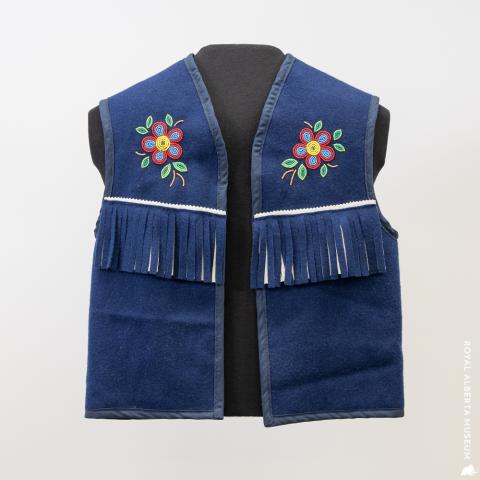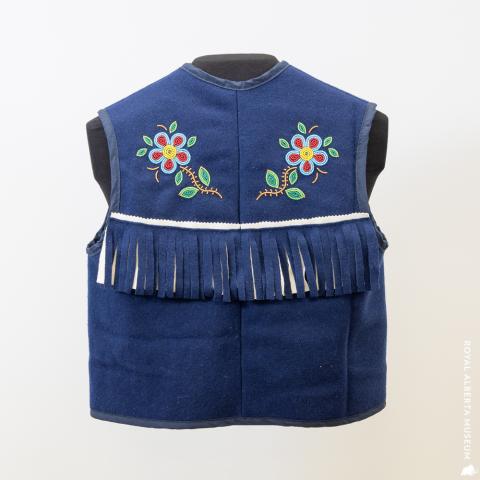Na’h e’tse’ah: Dene Hand Game
By Emma Knight, Assistant Curator, Indigenous Studies
June 16, 2020
Have you ever seen the Dene Tha’ hand game?
While developing our new galleries, we had the opportunity to work closely with Indigenous communities to develop displays that share their important stories.
Roy Salopree and his nephew Delbert Salopree from Meander River, Dene Tha’ Nation are members of our Indigenous Advisory Panel. They worked with museum staff on the Dene displays, including one about the fast-paced and exciting Dene hand game. Roy and Delbert helped write and edit the exhibit panel text, Roy made the drums and hand game set on display, and Roy, Delbert, and Sidney Chambaud each played an integral part in directing the accompanying film with Hidden Story Productions.
I had the opportunity to visit Bushe River in 2016 with former Curator Susan Berry during the Dene Tha’ Assembly to watch the hand game. We were both hooked but remain utterly confused by the complexity of the hand signals!
Watch the film here:
Video Transcript available below.
When I was in Meander River at the Dene Tha’ Assembly in 2017 I met Gladys Langkamp (nee Pastion), from Chateh and her husband Don. Gladys had a booth set up outside the arbour where she was displaying and selling some beaded rifle cases, mossbags and mukluks. We chatted a bit about the museum and realized that her late father, Jean Pastion, had made some drums for the museum in the 1990s. Gladys and I kept in touch and later that year we were fortunate enough to commission Gladys to make a beaded hide rifle case for the museum. The rifle case is a replica of the one her late mother Regina Pastion made for Gladys’ husband Don, which he holds close to his heart. Gladys’s rifle case is now in the gallery in the A’nƐ’d’tee-mbe-a’tslei: Everything Can Be Made with It display.
A couple of years later I asked Gladys if she would make a beaded wool vest for the museum, similar to those seen in the film. She agreed and we were able to purchase this young man’s vest for the collection. Gladys’ beadwork is absolutely spectacular. She was taught to bead by her late mother Regina Pastion and still has some of her mother’s beads and fabrics, which she uses in her work.
|
Image

|
Image

|
Our collecting practices have changed over the years. We still receive donations, however we also try to purchase objects directly from Indigenous makers and artists to support their work. This form of collecting helps us tell contemporary stories in our galleries, informed by Indigenous voices.
Come visit our “What Makes Us Strong” gallery to view the hand game film and 14 others that explore stories and issues important to Indigenous peoples across the province. You can also see Gladys’ beautiful beaded hide rifle case. If you want to look at more of Gladys’ work you can check out her Facebook page.
Mah’si Cho to Roy, Delbert, Sidney and all the Dene Tha’ Nation hand game players. Thank you Gladys for sharing your art, wisdom and skills with us!
Video Transcript
[Text on screen]
In the Dene Tha hand game, a player hides a token in one hand. The other hand is empty. The opposing team guesses which hand holds the token.
[Roy Salopree]
The importance behind the hand games are that it has been happening right from the beginning of time, right here in Meander River. They gather here and they play hand games.
[Delbert Salopree]
In Dene, we call it Na’h e’tse’ah.
[Roy Salopree]
Basically,it's about eight people to a team. Every team takes on each other and try and eliminate each other. But sometimes it's a challenge. It's a big battle when we get people together to play hand games.
[Sidney Chambaud]
It's a hide and seek game. One team hides, one team does hand gestures, which we say “shooters,” gives the hand signals. Eight sit on the mat and the other team also has eight, and traditionally it's one stick per person.
The team that's hiding it will hide an object. One empty hand, one object. So, it's empty, meaning I get to hide again, but I get one stick. And then it keeps going till the team wins all the sticks.
[Delbert Salopree]
Everybody has their own moves. It's a trickster game, you know. It's a guessing game. At the same time, how you're willing to fool the other person on which side it’s on, or trying to get them to guess which side is on.
[Roy Salopree]
The really important thing on the hand games is that they make people laugh, and make people, you know, bounce up and down and, you know, making those moves. The joy is always there. Not only that, but in the background, part of that is that some family may be grieving. These people come to the hand game and when the hand game is on, then we try to cheer that person that’s grieving.
In the Arbour like that, there's always respect for the drum in the Dene people. They really respect their drums, how they handle it, even how they carry it. The drum is very sacred in the Dene culture.
[Delbert Salopree]
You get down on the floor, and then you just entertain them. You entertain them as much as you can. You make these good little moves. You try to make people laugh.
[Roy Salopree]
I like to see the young people learn more. How to point their hands in that direction, and that's beautiful to see. I just love to see the young people get in the hand games in the future. That's already been planted for them. One day we'll have just a young people’s team. Today I'm still enjoying the hand game. I try to make people happy by my moves and get them to enjoy laughing, having a good time.
[Sidney Chambaud]
Hand games has always brought us together. It gives us enjoyment, like I said, the joy of that game. Once you experience it, you just fall in love with it.
[Roy Salopree]
It’s ever awesome!